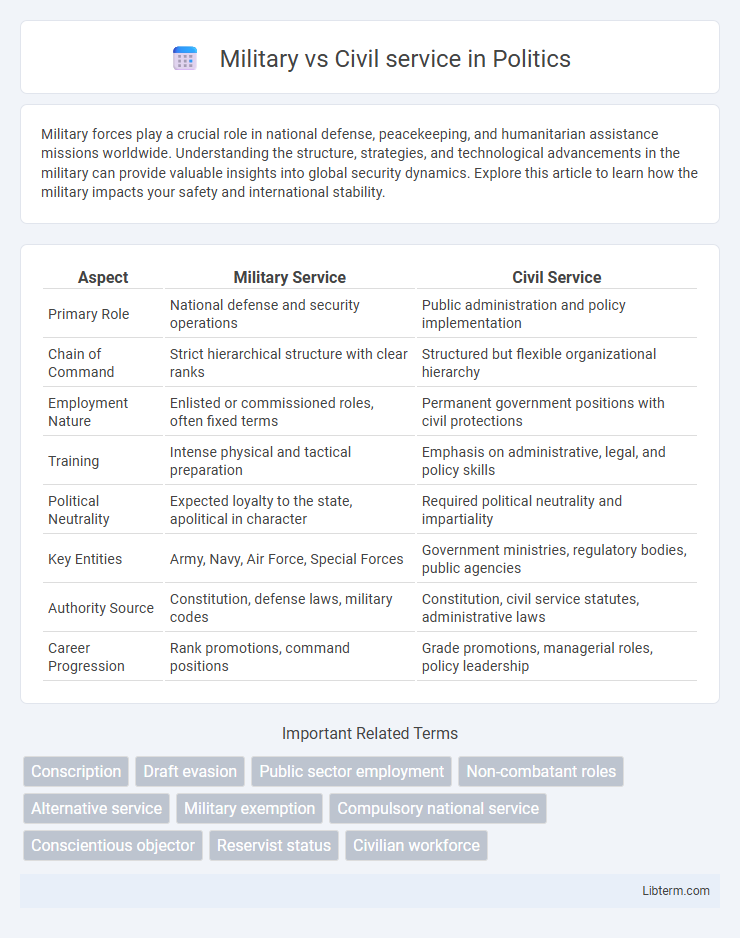Military forces play a crucial role in national defense, peacekeeping, and humanitarian assistance missions worldwide. Understanding the structure, strategies, and technological advancements in the military can provide valuable insights into global security dynamics. Explore this article to learn how the military impacts your safety and international stability.
Table of Comparison
| Aspect | Military Service | Civil Service |
|---|---|---|
| Primary Role | National defense and security operations | Public administration and policy implementation |
| Chain of Command | Strict hierarchical structure with clear ranks | Structured but flexible organizational hierarchy |
| Employment Nature | Enlisted or commissioned roles, often fixed terms | Permanent government positions with civil protections |
| Training | Intense physical and tactical preparation | Emphasis on administrative, legal, and policy skills |
| Political Neutrality | Expected loyalty to the state, apolitical in character | Required political neutrality and impartiality |
| Key Entities | Army, Navy, Air Force, Special Forces | Government ministries, regulatory bodies, public agencies |
| Authority Source | Constitution, defense laws, military codes | Constitution, civil service statutes, administrative laws |
| Career Progression | Rank promotions, command positions | Grade promotions, managerial roles, policy leadership |
Definition of Military and Civil Service
Military service involves active duty personnel serving in armed forces for national defense, including roles in the army, navy, air force, and marines. Civil service refers to government employment in administrative, clerical, and regulatory roles aimed at implementing public policies and delivering essential services to citizens. Both sectors require commitment to public duty but differ in function, with military service centered on defense operations and civil service focused on governance and public administration.
Historical Context of Service Systems
Military and civil service systems have evolved from distinct historical functions, with military service rooted in defense, conquest, and state sovereignty, often institutionalized through conscription or voluntary enlistment since ancient civilizations. Civil service emerged primarily to administer government functions and public policy, gaining formal structure during the bureaucratic expansions of the 18th and 19th centuries, notably with reforms like the British Civil Service Act of 1855. Both systems reflect evolving state priorities, with military service emphasizing security and discipline, while civil service focuses on governance, administration, and public welfare.
Recruitment and Selection Processes
Military recruitment emphasizes physical fitness, psychological resilience, and specialized skill assessments, ensuring candidates meet stringent standards for defense roles. Civil service selection prioritizes competencies such as administrative expertise, problem-solving, and communication skills through structured exams and interviews tailored to public sector requirements. Both processes utilize background checks and eligibility criteria to maintain integrity and suitability for their respective roles.
Training and Preparation
Military training emphasizes rigorous physical conditioning, tactical skills, and combat readiness to prepare personnel for high-stress and hostile environments. Civil service training prioritizes administrative expertise, policy implementation, and public interaction to ensure effective governance and community support. Both require discipline and specialized skills but cater to distinct operational demands and objectives.
Roles and Responsibilities
Military service involves roles such as defense operations, combat readiness, strategic planning, and national security enforcement, requiring rigorous training and discipline. Civil service focuses on administrative functions, public policy implementation, regulatory oversight, and provision of essential public services to ensure government efficiency and societal welfare. Both sectors contribute to national stability but differ fundamentally in operational scope and mission priorities.
Benefits and Compensation
Military service offers comprehensive benefits including tax advantages, retirement pensions after 20 years, affordable healthcare through TRICARE, housing allowances, and education benefits like the GI Bill. Civil service positions provide stable government employment with competitive salaries, federal health insurance plans, retirement pensions through the Federal Employees Retirement System (FERS), and paid leave options. Both career paths offer job security and opportunities for professional development, but military roles often include additional allowances and combat-related incentives not typically found in civil service compensation packages.
Legal Obligations and Duration
Military service typically involves legally binding conscription or enlistment with strict adherence to national defense laws and obligations, often requiring a commitment ranging from 12 months to several years depending on the country. Civil service obligations are usually defined by government statutes and vary widely, focusing on administrative or community roles with durations that can be fixed-term or contract-based, commonly lasting 1 to 3 years. Legal frameworks for military service emphasize defense readiness and national security, whereas civil service laws prioritize public administration and social welfare functions.
Societal Impact and Public Perception
Military service often fosters societal cohesion through national defense and disaster response, earning respect for discipline and sacrifice. Civil service significantly influences public welfare by managing essential government functions, health, and education, contributing to societal stability and development. Public perception tends to view military service as heroic and patriotic, while civil service is valued for its role in sustaining daily governance and community well-being.
Career Opportunities After Service
Military service offers diverse career opportunities in defense contracting, cybersecurity, and government agencies, leveraging skills such as leadership, discipline, and technical training. Civil service careers provide pathways in public administration, social services, and policy development, capitalizing on expertise in governance and community engagement. Veterans transitioning from military roles often find a competitive advantage in both sectors due to their specialized experience and commitment to public service.
Challenges and Ethical Considerations
Military service faces challenges such as adherence to strict hierarchies, exposure to combat-related stress, and navigating rules of engagement that can involve life-or-death decisions. Civil service encounters ethical considerations centered on maintaining impartiality, protecting public interests, and avoiding conflicts of interest while implementing policies. Both sectors demand rigorous accountability and integrity but differ fundamentally in operational environments and the nature of ethical dilemmas encountered.
Military Infographic

 libterm.com
libterm.com